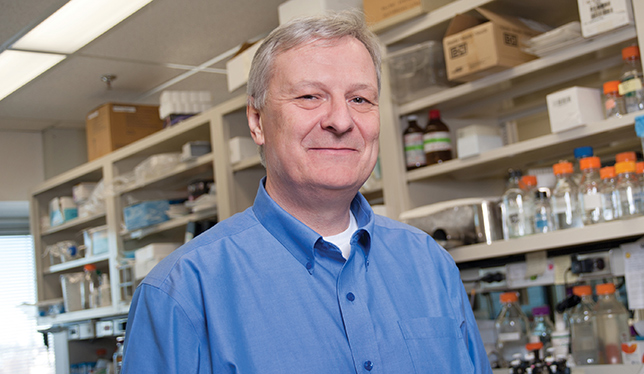
Research Institute.
When the Canadian Institutes of Health Research attempted to reform how it awards grants earlier this year, the backlash from the science community was swift, vociferous and unprecedented, according to prominent cell biologist Jim Woodgett. A professor in the department of medical biophysics at the University of Toronto and director of research at the Lunenfeld-Tanenbaum Research Institute, Dr. Woodgett spearheaded the protest over the CIHR reforms. Among these were changes to the grant funding streams; an overhaul of the grant writing process and – the primary concern for many scientists – doing away with face-to-face peer reviews of grant applications in favour of a virtual, anonymous review system. Dr. Woodgett penned an open letter to Health Minister Jane Philpott criticizing the changes and within days had more than 1,300 supporting signatures from scientists and researchers. That prompted the minister to hastily convene a meeting to address their concerns. Dr. Woodgett says that meeting on July 13 was somewhat beneficial, but told University Affairs magazine that with the next round of research applications looming, the CIHR grant system “is still a mess.”
University Affairs: Was there one final straw, or a series of incidents that provoked you to write your letter to the minister of health?
Jim Woodgett: There were a lot of final straws – and an increasing incredulity over the way CIHR was handling the project grants competition. In all of our institutions and in universities across the country, we had various scientists who had agreed to be reviewers for CIHR’s grant competitions, but it was getting into late April and they still had not received the applications to review. That started to cause problems because they then had less time to do the work.
Also, the reviewers were receiving lists of applications that CIHR felt they were competent to review, but were in fact clear mismatches. We had, for example, clinician scientists who work in health systems research being asked to review cell biology applications. They came to me and said, “What do I do?” I said, “Well, you can’t review them. You’re not competent to review them. It’s not your expertise.” Meanwhile, CIHR was pushing back saying, “You’ve got to do this.”
All of this was exacerbated by the application pressure – there were 3,820 applications, which is high because CIHR had cancelled previous competitions, so there was a pent-up demand. They also made a policy decision not to allow those people who were applying to review applications. So that was the lion’s share of the conventional review pool for CIHR. We found out later they asked 9,000 people to be reviewers and 6,500 turned them down. This was in May and June, so they were scrambling because at that point the review process should have been under way.
UA: One of the most contentious issues was the decision to move away from face-to-face peer review for funding applications. Why is that so critical?
Dr. Woodgett: When you go to a face-to-face review committee, you discuss each of the applications you reviewed and your scoring of them. You justify your rationale in front of your peers. There’s also usually a chair and a scientific officer to ensure everyone is treated fairly. It’s like a conversation – you can make corrections and ask questions. That is all gone. The virtual review system was essentially anonymous and completely arm’s length, so there was no peer pressure. Some of the reviews that were submitted were incredibly limited, to the point of providing no information. It was a true failure of the virtual review process.
UA: Were you surprised by the number of the scientists who added their names to your letter to the minister of health?
Dr. Woodgett: There are a lot of young and mid-career investigators [in Canada], and you don’t want to bite the hand that feeds you. But they stuck their necks out, so I was surprised. And there was a lot of feedback. I had tons of emails from people explaining the situation they were in and not knowing what to do because they could see this was just going to be such a disaster of a competition.
UA: Was that one of the benefits from the controversy, the way it galvanized the research community?
Dr. Woodgett: There is definitely a silver lining there. The minister of health reacted so quickly and arranged a meeting within a week or two. About 60 people turned up on very short notice and at the beginning of the summer. So that was pretty amazing. It was also ironic getting 60 people together for a face-to-face meeting to discuss why CIHR got rid of face-to-face meetings.
UA: What came out of that meeting with the deputy minister of health, Simon Kennedy?
Dr. Woodgett: What came out of that meeting was a series of recommendations. For example, the reformed application process was very structured and character-limited – a very cookie-cutter approach to science in which everyone had to write in the same way, which is the antithesis of creativity. That was thrown out, so applicants now have 10 pages to emphasize what they think is important in the proposal.
There is also a commitment to face-to-face review, although it is sort of an in-person and virtual hybrid, and a lot of people are still confused by this. CIHR used to have about 50 panels, with 10 to 15 scientists on each panel with a discipline focus. So you would have dentistry, then molecular biology and cancer, for example. There would be three neuroscience panels, heart disease, and so on. CIHR refuses to go back to that. They are proposing clusters, with about 30 super-clusters which will be more multidisciplinary, and these clusters will be virtual. Each reviewer will get a number of applications to review and they will submit their scores to CIHR along with their rationale for those scores.
Based on those initial reviews, 60 percent of the applications will be triaged – they will not be discussed further. A subset of those clusters will then meet in Ottawa to discuss the top 40 percent of applications as well as those which may have received very divergent scores. As a reviewer, you don’t know whether you’re going to be invited to the face-to-face reviews in Ottawa. Even if you aren’t [invited], your reviews may well be discussed by others who are at the meeting and they will know who you are. So there’s a greater amount of peer pressure being applied. The belief is that reviewers will be more conscientious in how much effort they put into the reviews. That’s definitely a positive.
UA: Is there a lot that remains to be resolved between researchers and CIHR?
Dr. Woodgett: I think CIHR had a plan with the reforms and they expected by the end of this year everything would be hunky-dory. There was a transition phase where they cancelled a couple of competitions and they knew that would cause some disruption, but they expected everything to be on the new schedule as of now. That’s not the case. I think they were also expecting to get additional funding and part of this [mess] is all due to the fact that less funding is available. But it’s also due to the terrible implementation strategy they used where they caused this back-up in demand. There is still a lot of uncertainty and when people lose faith [that their work will get funded], that’s when they start submitting more grants because they want to have more kicks at the can. And the system is already overburdened.
The idea of this hybrid face-to-face process is a step forward, but that’s going to be overshadowed by the fact that there’s even less funding available. It’s pretty depressing and this has an impact on a lot of people. A lot of the scientists [applying for these grants] are tenured or they are in positions which are reasonably secure, but they have had to downsize their labs. The people they let go are highly skilled technicians, many of whom have been working for over a decade. It’s something you don’t recover from very easily.
UA: How would you describe the situation, moving forward?
Dr. Woodgett: I think bleak is a pretty fair encapsulation of the temperament of the research community in Canada. There are very few people who feel we are back on the right track. CIHR is an incredibly important organization. [But] it’s in a mess. This is not going to be solved overnight. There needs to be a well thought-out plan and we need to buy some time.
At universities across the country, there are people in biology, biochemistry, physiology, neuroscience departments who are really struggling. It’s going to impact universities because if we don’t take on the graduate students because we can’t fund them, the graduate student involvement goes down and that impacts the bottom line of universities. It causes a career interruption in terms of the pipeline for future researchers.
This interview was condensed and edited for clarity.

Ahmen. CIHR is a mess and all of this was predicted back in 2012 when the reforms were first discussed broadly with researchers across the country. Several prominent scientists raised concerns about the reforms and penned more than one letter to CIHR:
see: http://www.csmb-scbm.ca/uploads/Tyers_UdeM_CIHR%20Reform%20letter.pdf
Of course we didn’t have the same degree of wide spread use of Twitter, blogging or other social media engagement of the research community in 2012. My how things have changed in 4 years!
Many thanks to the social media “warriors” holding CIHR and its administration to account.
Be forewarned CIHR, you cannot manipulate public opinion or the research communities expectations of this debacle anymore. Just a few key strokes on twitter and every mistakes is broadcast to 1000s of people. We have never been so well informed about the inner workings of Federal research funding then we are today.
Hank